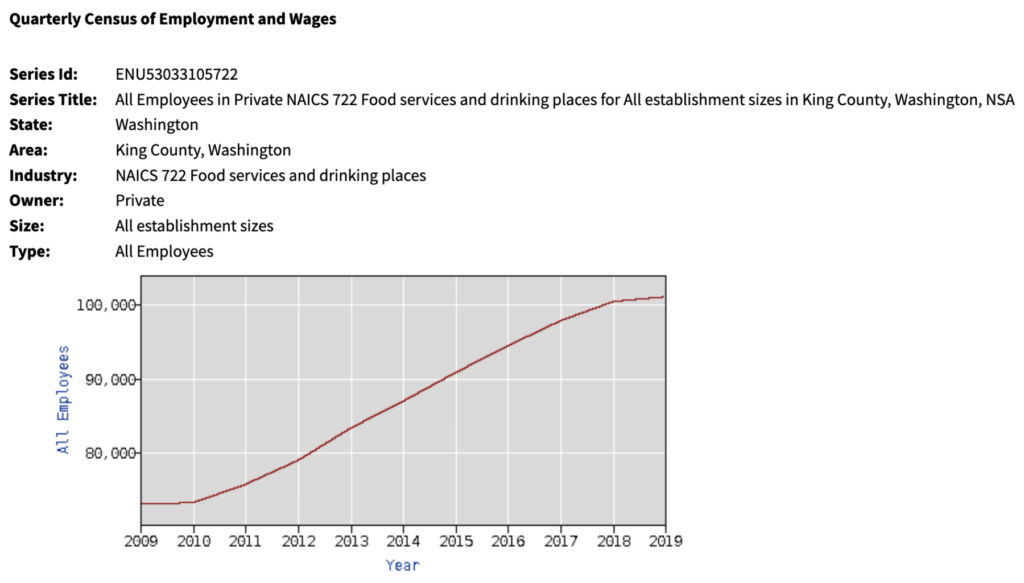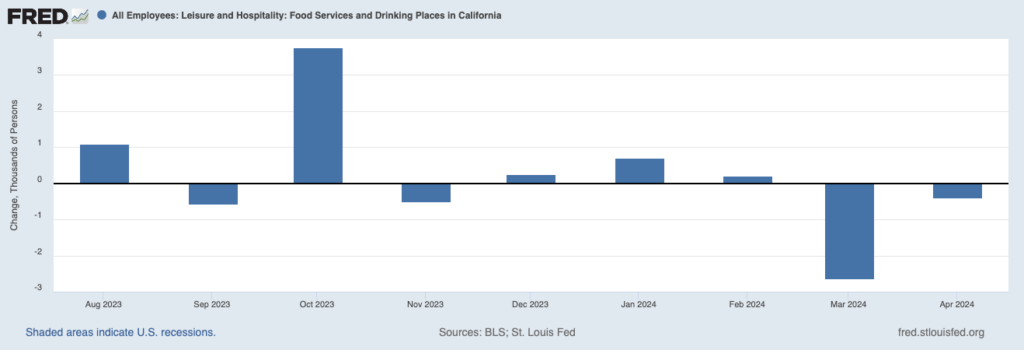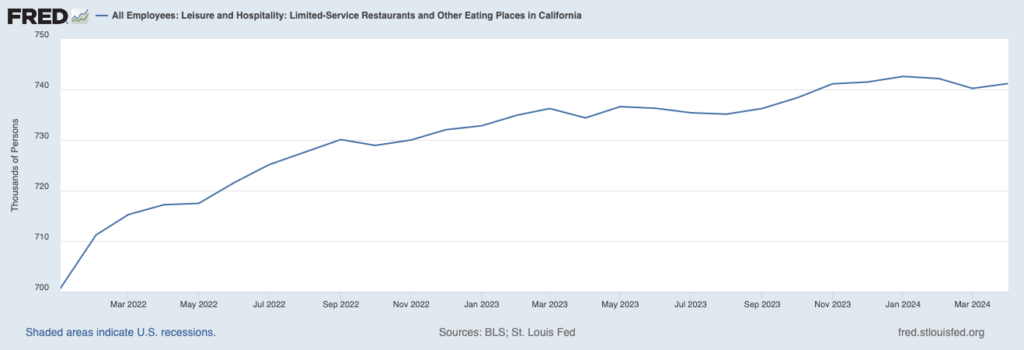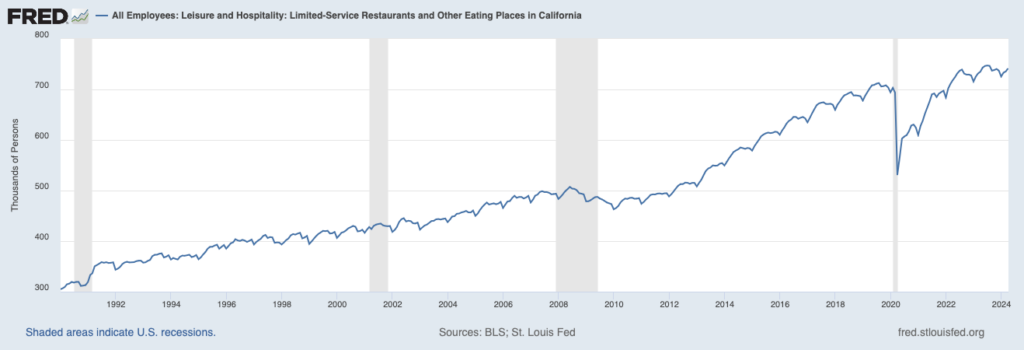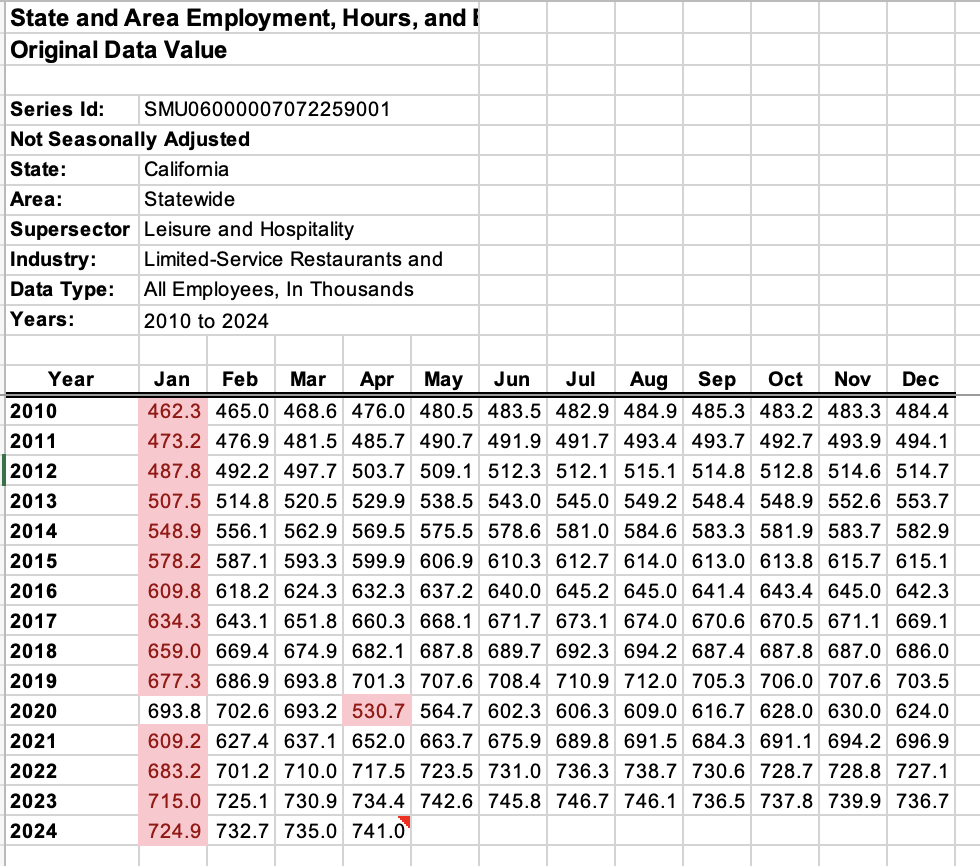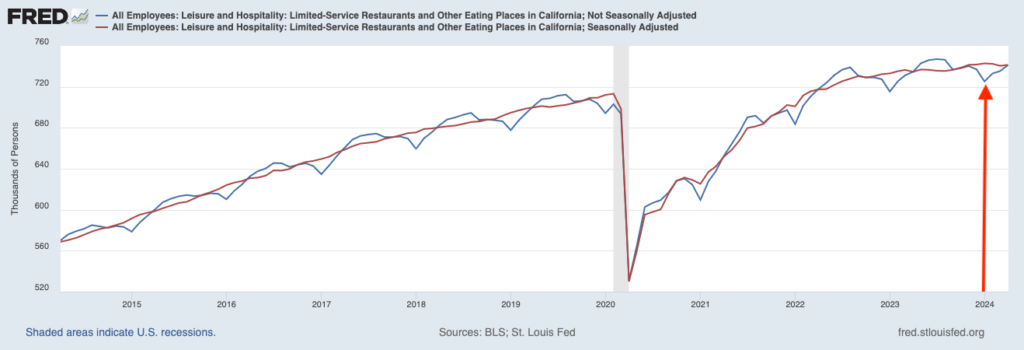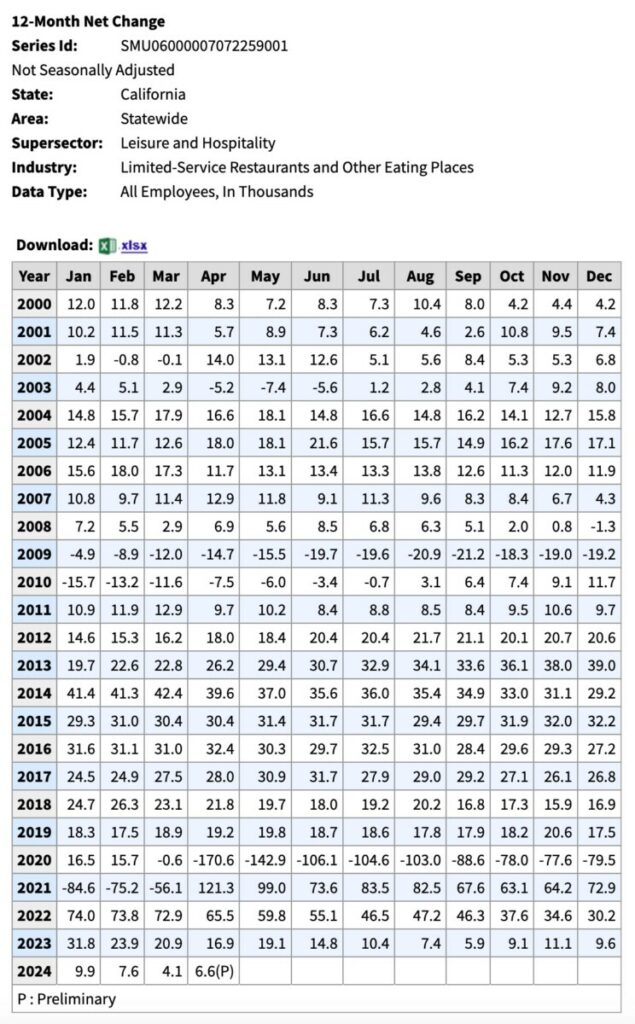@TBPInvictus here.
About a decade ago, the city of Seattle undertook to raise its minimum wage, over time, to $15/hour. Massive credit goes to my friend Nick Hanauer for his efforts that made that happen.
What followed in the immediate aftermath of both the announcement and implementation was nothing less than an apocalyptic, collective head explosion on the right about the devastating effects the increase would have, particularly in the food services sector:
However, there’s little doubt that the city’s heralded food scene is running scared. — Weekly Standard
Restaurants are closing at higher than normal rates. — Tim Worstall
According to the Washington Policy Center, it’s already having unintended consequences: namely, forcing restaurants to close. — NY Post
I documented the errors throughout. The biggest idiocy of those efforts was the simple fact that critics focused on the Seattle-Tacoma-Bellevue Metropolitan Statistical Area (MSA), a region vastly larger and more populated than the city of Seattle proper (King County). Leading the charge for this bit of statistical sleight of hand was AEI’s Mark Perry, who never let the truth get in the way of a good narrative.
Using the Quarterly Census of Employment and Wages – a very accurate survey that comes with a long lag – we can drill down to King County and see, quite clearly, that the restaurant sector continued hiring apace throughout the incremental increases in the minimum wage.
The minimum naysayers were collectively and unequivocally WRONG.
***
That was in the 2010s. The 2020s version of minimum wage fear-mongering is an even larger and more obvious analytical error.
The NY Post is back at it again, this time with California’s minimum wage. The story titled “California fast food restaurants have cut 10,000 jobs thanks to state’s $20 minimum wage: trade group.” They rely on an industry trade group that made a large and obvious error:
“California fast food restaurants have slashed nearly 10,000 jobs because of the state’s new $20 minimum wage as struggling franchises cut labor costs and raise prices to survive, a major trade group said Thursday. […]
“Manzo said nearly 10,000 jobs have been cut across fast food restaurants since Newsom signed California Assembly Bill 1287 into law last year, adding that officials were living in a “fantasyland” by thinking that drastic wage increases will help workers or businesses.”
Manzo said it, so it must be true, right? Well, not exactly.
Barry has written extensively about denominator blindness, i.e. throwing out a number without any context whatsoever. Is 10,000 restaurant jobs a lot or a little? What is the size of data set under consideration? Does the state have 15,000 restaurant jobs overall or 150,000? Well, the number is nearly 10X that — 1.470 million to be precise:
Losing 10k jobs on 1.470 million employed is a rounding error of less than 1 percent — 0.68% to be exact.
To add insult to analytical injury, it turns out even that small change is not true. Since last August 2023, just prior to Newsom signing the legislation, employment in the sector is flat, changing by such a small amount as to be statistically insignificant (+2k):
Misinformation is ubiquitous today. It seems a disproportionate amount of it comes from right-wing economists. Whether through innumeracy or purposeful partisan attempts at misleading the public, they appeal to those in an ideological bubble who simply want their priors confirmed. Jonathan Swift reminds investors of the dangers here: “A Lie Can Travel Halfway Around the World While the Truth Is Putting On Its Shoes.”
This is the world in which we now live. You must engage in information hygiene, be very aware of what sources you rely on, and recognize who are regular fonts of junk science, misinformation, and partisan garbage.
***
I spent some time investigating the origins of Manzo’s NY Post claim and found it led to the Hoover Institution, which apparently riffed off a story that appeared in the WSJ in March. The Journal did the math as follows:
California had 726,600 people working in fast-food and other limited-service eateries in January, down 1.3% from last September, when the state backed a deal for the increased wages.
So, couple of things:
The Journal, Hoover, and Post used a subset of restaurant employees, i.e. SMU06000007072259001 Limited-Service Restaurants and Other Eating Places. Fair enough, although it only captures, as noted, a subset of the entire category, and the other, full-service restaurants, may have been growing.
It appears to me that the Journal got that number from BLS. However, BLS only offers the series without seasonal adjustment; this makes a very meaningful difference.
The Federal Reserve Economic Data (FRED) from the St. Louis Fed — one of the internet’s greatest economic resources — takes many series and seasonally adjusts them, which creates a better model for understanding specific data series — especiallty in Housing, Retail Sales, and Employment
The result directly contradicts the WSJ’s narrative:
Why is seasonal adjustment so important? We do not freak out because suddenly millions of retail jobs disappear every January; nor do we fret over home sales falling off each year from August to December. These economic sectors have a seasonality to them, and adjusting for that gives us a better sense of the entire picture.
To highlight the importance of seasonal adjustments, below is a longer view of the same series without seasonal adjustments. What’s fascinating is that the series peaks annually in the fall and drops precipitously by January; this is the exact timeframe referenced by the WSJ.
Newsom signed the legislation in Fall, just before the weakest period of employment (NSA). We don’t expect governments to time their pronouncements around analyses such as these, but maybe they should.
Looking at the chart above in table format (from 2010), it becomes quite evident that, on a non-seasonal adjustments basis, the trough in this series occurs, with precision, every January. (except during the pandemic):
So the Journal misled its readers — either deliberately or by accident — due to the discrepancy between the September to Januuary differential between the non-seasonal adjustments (NSA) and nonseasonal adjustments (SA) data series.
A friend at the St. Louis Fed confirmed the shenanigans: “Using NSA data is one of the most common mistakes I see in data reporting. Even when I talk to the public people seem skeptical of the seasonal adjustment process and why it is done.”
That the WSJ would make such a sloppy error in the first place is somewhat appalling. That an economics professor would parrot that error without first double-checking the numbers is downright embarrassing. That a labor-unfriendly trade group and the NY Post would then trumpet it is par for the course.
So, the point remains: Wall St. Journal, Hoover, NY Post are generally not where you want to be getting your news, assuming you’re a truth-seeker.
~~~
Barry adds:
There are two bad players here: The partisans who know they are abusing the data, and the naive journos being taken advantage of whose editors are too innumerate to understand even basic modeling issues like seasonal adjustments.
Best practices when using data with a high degree of seasonality is to use Year-over-Year basis (NSA) for your comparison. This removes the seasonality factor. September 2023 when the legislation was introduced against September 2022 one-year earlier shows the impact without requiring a seasonality adjustment.
So what does it look like when we compare year-over-year data? As it turns out, every single month since the legislation was introduced saw gains in the sector over the prior year — not losses.
California Net Change in QSR Employment (12 Month Change)
September 2023 (vs 2022): 5,900
October 2023: 9,100
November 2023: 11,100
December 2023: 9,600
January 2024: 9,900
February 2024: 7,600
March 2024: 4,100
April 2024: 6,600
Data source is BLS May 2024; see chart below:
The problem with all of this misleading innumeracy comes from Brandolini’s law:
The amount of energy needed to refute bullshit is an order of magnitude bigger than that needed to produce it…
But that is our charge, and since as investors understanding the world as it is continues to be so important, we continue to perform these exercises debunking bullshit on a regular basis.
READ ABOUT THE IMPORTANCE OF SEASONAL ADJUSTMENTS HERE.
***
UPDATE June 11 2024:
California Governor Newsom’s office corrects several outlets that are using inappropriate (NSA) data to peddle a false narrative. Here is the Governor’s office letter to the California Globe:
HERE ARE THE FACTS: According to the Bureau of Labor Statistics, California has added jobs in limited service restaurants (fast food) both since Gov. Gavin Newsom signed AB 1228 the FAST Recovery Act in September 2023 and since the law’s new $20 minimum wage for fast food workers took effect April 1, 2024.
- According to the BLS, there were 736,500 jobs in California limited service restaurants in September 2023. In April 2024 there were 741,000 jobs in the industry. That is an increase of 4,500.
- Similarly, there were 734,400 fast food jobs in California in April 2023, and a year later, in April 2024, there were 741,000 jobs. That is an increase of 6,600.
- It is just not true that the fast-food industry has cut jobs since the signing of the FAST Recovery Act or since its historic minimum wage increase went into effect.
- In fact, leading up to this year’s implementation the number of employees in this sector increased each month leading up to April.
The data is from https://data.bls.gov/PDQWeb/sm and I have included a screen shot below for ease. The data the trade group uses cherry picks from Aug/Sept 2023 to Jan 2024 (an incomplete and inaccurate use of the data) – leaving out the data from the months of February, March, and April – which all saw increases.
Pushing a false narrative despite overwhelming evidence that your “facts” are incorrect or applied inappropriately for ideological reasons don’t care about accuracy. Investors must always be careful when consuming content from social or mass media.
Previously:
Thanks, Joe! Updating Brandon’s Restaurants (June 6, 2024)
Brandon’s Restaurants (May 30, 2024)
Seattle Study’s Shocking Conclusion: Minimum Wage Increases Benefits Workers (October 31, 2018)
Jobless in Seattle? Not Yet, Anyway. Part 2 (April 10, 2015)
Sources:
California fast food restaurants have cut 10,000 jobs thanks to state’s $20 minimum wage: trade group
ByAriel Zilber
NY Post June 6, 2024
California Restaurants Cut Jobs as Fast-Food Wages Set to Rise
By Heather Haddon
WSJ, March 25, 2024
California Loses Nearly 10,000 Fast-Food Jobs After $20 Minimum Wage Signed Last Fall
By Lee Ohanian
Hoover, April 24, 2024
California fast-food-minimum-wage law is ALREADY smashing small biz and consumers
By Post Editorial Board
June 7, 2024

